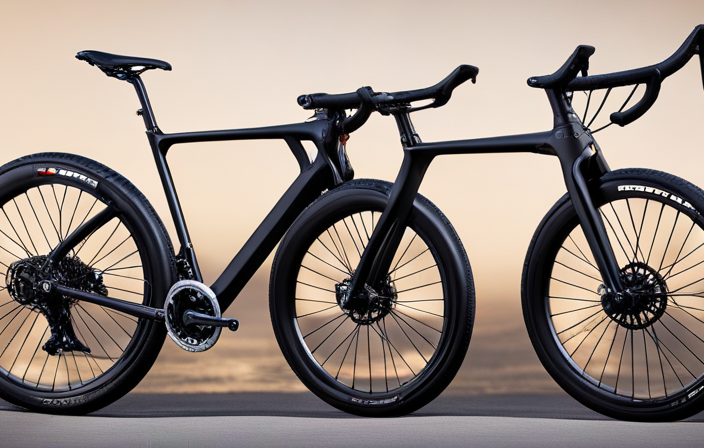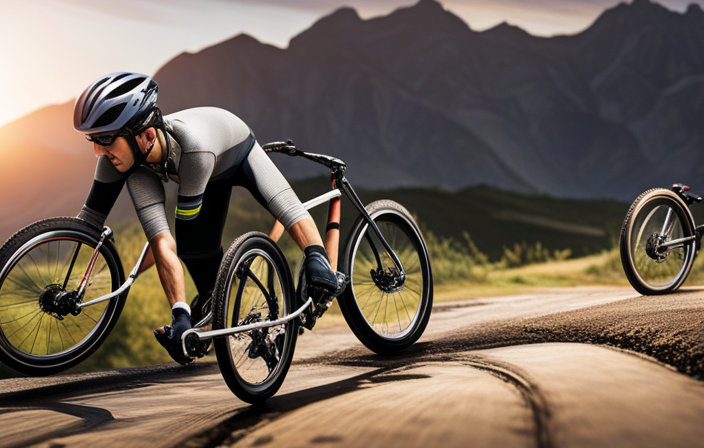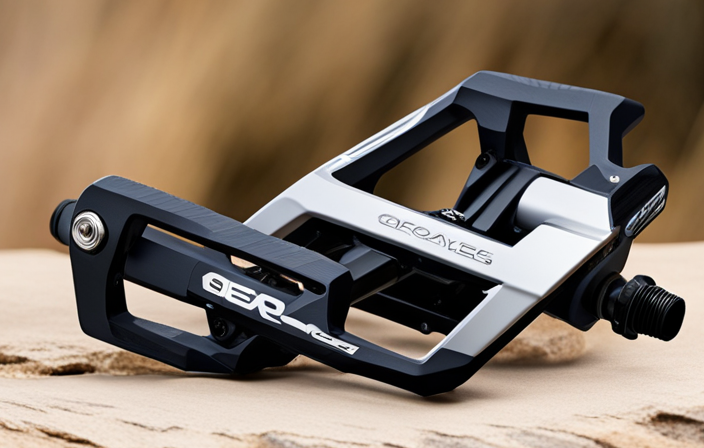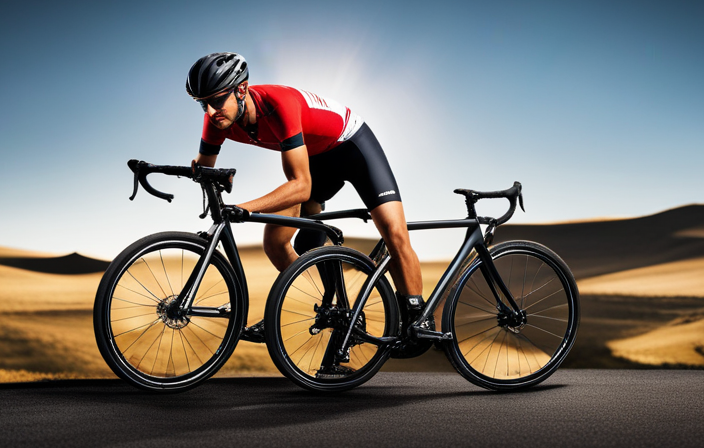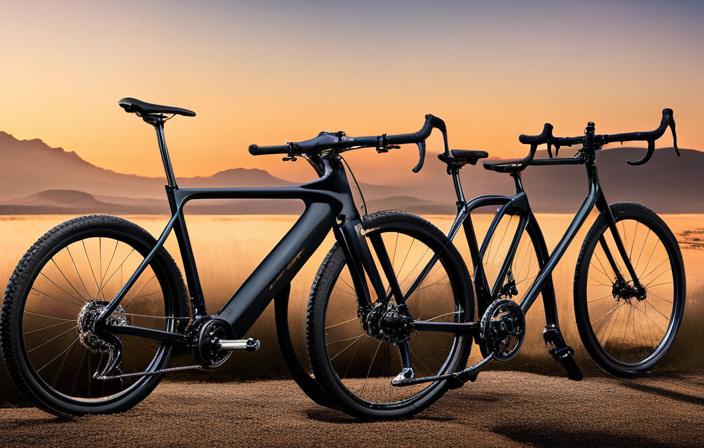Were you aware that gravel biking has risen to become one of the most rapidly expanding segments in cycling, experiencing a 400% surge in popularity over the last ten years?
If you’re ready to venture off-road and explore scenic gravel roads, it’s crucial to have the right bike for the job.
In this article, I will guide you through the various types of bikes suitable for gravel riding, provide essential safety tips, and offer advice on planning your exciting gravel adventures.
So let’s dive in and find out what kind of bike you need to conquer those challenging gravel roads!
Key Takeaways
- Gravel-specific bikes, modified mountain bikes, cyclocross bikes, and adventure bikes are all suitable for riding on gravel roads.
- Key features to look for in a bike for gravel riding include durability and load capacity, long-distance comfort, features for bikepacking, and wide tires for enhanced stability.
- It is important to choose the right tires for different terrains and to regularly maintain and fuel both the bike and the body for optimal performance.
- Proper bike fit and positioning, including finding the right fit for a gravel bike and adjusting handlebar and saddle positions, can greatly improve comfort and performance.
Gravel-Specific Bikes
If you’re looking to ride gravel roads, you’ll need a gravel-specific bike. These bikes are designed to handle the unique challenges that come with riding on loose surfaces and rough terrains. They have specific features that make them more suitable for gravel riding compared to other types of bikes.
For beginners who are just starting out on their gravel adventures, there are a few key pieces of advice to keep in mind when choosing a gravel-specific bike. Firstly, it’s important to consider the recommended tire width. Gravel roads can be unpredictable, with varying levels of smoothness and roughness. A wider tire provides better stability and traction on these surfaces, making your ride more enjoyable and safer.
Typically, gravel-specific bikes have tires ranging from 35mm to 45mm in width. This wider tire allows for lower tire pressure, which helps absorb bumps and vibrations while providing better grip on loose terrain. It’s worth noting that some riders prefer even wider tires for added comfort and confidence on rougher gravel roads.
Now let’s transition into the next section about modified mountain bikes without missing a beat.
Modified Mountain Bikes
Modified mountain bikes, also known as crossover bikes, are typically used for riding on gravel roads. These bikes are designed to handle a variety of terrains, including rough gravel paths. One of the key features of modified mountain bikes is their suspension options. This allows riders to adjust the level of suspension based on the type of terrain they are riding on.
When it comes to riding on gravel roads, having a bike with suspension can make a big difference in terms of comfort and control. The suspension helps absorb bumps and vibrations, making your ride smoother and more enjoyable. It also helps improve traction, allowing you to maintain better control over the bike when navigating loose or uneven surfaces.
In addition to suspension options, modified mountain bikes often have wider tires compared to traditional road bikes. These wider tires provide better stability and grip on loose surfaces like gravel. They also offer increased puncture resistance, reducing the risk of flat tires while riding.
Transitioning into the next section about ‘cyclocross bikes’, it’s worth noting that these modified mountain bikes share some similarities with cyclocross bikes in terms of their versatility and suitability for different terrains.
Cyclocross Bikes
Cyclocross bikes are incredibly versatile, making them suitable for various terrains such as gravel roads, mud, and even pavement. They are designed for racing purposes, with a lightweight frame and aggressive geometry that allows for quick acceleration and maneuverability.
These bikes also come equipped with key features like wider tires, disc brakes, and extra clearance to accommodate mud build-up during races or adventurous off-road rides.
Versatility for Various Terrains
When riding gravel roads, it’s important to have a bike that can handle various terrains. One of the key factors in ensuring versatility for different types of terrain is choosing the right tires. Bikepacking essentials also play a role in determining the suitability of a bike for gravel riding. The ability to carry essential gear and supplies is crucial when embarking on long rides through different environments.
In terms of tires, wider options with aggressive tread patterns are preferred for added traction and stability on loose gravel surfaces. These tires provide better control and reduce the risk of sliding or skidding. Additionally, having tubeless-ready tires can be beneficial as they allow for lower tire pressures, enhancing comfort and reducing the chances of punctures.
Moving forward into the next section about how these bikes are suitable for racing and adventure, it’s important to consider other aspects such as frame geometry and components that contribute to their performance capabilities without compromising comfort.
Suitable for Racing and Adventure
These versatile bikes are perfect for both racing and going on adventures. Gravel bikes are designed to handle a variety of terrains, making them suitable for riders who enjoy the thrill of racing as well as those who seek adventure off the beaten path.
Unlike road bikes, which are optimized for smooth pavement, gravel bikes have specific features that enhance their performance on rough surfaces. They typically have wider tires with more tread for better traction, a more relaxed geometry for added stability, and disc brakes for improved stopping power. These features make gravel bikes capable of tackling gravel roads with ease while maintaining speed and control.
Transitioning into the next section about ‘key features,’ it’s important to understand how these characteristics contribute to the overall functionality of a gravel bike.
Key Features
To fully experience the versatility of a gravel bike, it’s important to understand its key features. Gravel bikes are designed with durability in mind, with wider tires that provide stability and traction on rough terrains, reducing the risk of punctures. They also come equipped with disc brakes that offer reliable stopping power even in wet or muddy conditions.
Choosing the right gear is essential for riding on gravel roads. Gravel bikes often have a wide range of gears, allowing you to tackle both steep climbs and fast descents effortlessly. Some models also feature additional mounting points for racks and fenders, making it easier to carry equipment or ride in different weather conditions.
Transitioning into the subsequent section about adventure bikes: Now that we’ve explored the key features of gravel bikes, let’s delve into the world of adventure bikes and uncover their unique characteristics.
Adventure Bikes
If you’re planning to ride gravel roads, an adventure bike is what you need. Adventure bikes are specifically designed to handle a variety of terrains, making them ideal for off-road adventures. One of the key features of adventure bikes is their versatility. They come equipped with features such as wider tires and disc brakes, which provide better traction and control on rough surfaces. Additionally, adventure bikes have a more relaxed geometry compared to road bikes, offering a comfortable riding position for long hours in the saddle.
When it comes to choosing the right tires for your adventure bike, there are a few factors to consider. First, look for tires that have a tread pattern suitable for gravel roads. These will typically have larger knobs or blocks that offer better grip on loose surfaces. Additionally, consider the width of the tire. Wider tires provide more stability and traction on uneven terrain.
Transitioning into the subsequent section about touring bikes, it’s worth mentioning that while adventure bikes excel in off-road conditions, touring bikes are better suited for long-distance road riding. So if you’re looking to explore both gravel roads and paved routes, a touring bike might be the next step for you.
Touring Bikes
When it comes to touring bikes, there are several key points to consider.
First and foremost is durability and load capacity. These bikes need to be able to withstand the rigors of long-distance travel while carrying heavy loads.
Secondly, long-distance comfort is crucial for those extended rides. Look for features like relaxed geometry, suspension options, and ergonomic handlebars that will keep you comfortable in the saddle for hours on end.
Lastly, if you’re into bikepacking, make sure to check out the features that cater specifically to this style of adventure cycling. Look for mounting points for racks and panniers, extra bottle cage mounts, and integrated storage solutions.
Durability and Load Capacity
Durability and load capacity are important factors to consider when choosing a bike for riding gravel roads. When it comes to durability, you want a bike that can withstand the rough terrain and potential impacts that come with gravel riding. However, you also need to balance this with weight, as a heavy bike can be more difficult to maneuver on the trails. It’s important to find a bike that offers a good balance between durability and weight.
Load capacity is another crucial consideration, especially if you plan on bikepacking or carrying gear for long-distance rides. A higher load capacity allows you to carry more supplies without compromising the bike’s performance. Look for bikes with sturdy frames and racks that can handle the weight of your gear.
Transitioning into the next section about long-distance comfort, it’s essential to find a bike that not only offers durability and load capacity but also provides comfort during those long rides on gravel roads.
Long-Distance Comfort
Finding a bike that offers durability and load capacity while also providing long-distance comfort is crucial for enjoyable rides on gravel roads. When it comes to long distance endurance, having a comfortable bike is essential. Look for features such as an upright riding position, wider tires with lower pressure, and a suspension fork or seat post to absorb vibrations and bumps along the way. Additionally, consider investing in bikepacking essentials like a sturdy frame and ample storage options to carry all your gear for those extended trips. These features will not only enhance your comfort but also ensure that you can tackle any terrain with ease.
Transitioning into the next section about ‘features for bikepacking,’ it’s important to consider other aspects that will make your gravel riding experience even better.
Features for Bikepacking
When it comes to long-distance comfort on gravel roads, there are a few key features to consider. Look for a bike with plenty of mounting points for racks and bags, as well as provisions for extra water bottles. Consider getting a frame with clearance for wider tires, which will provide better traction and stability on rough terrain. Additionally, look for a sturdy build that can handle the weight of your gear without compromising performance. Bikepacking gear is essential for carrying all your necessary equipment, and having the right tools can make or break your trip. With these features in place, you’ll be ready to tackle any bikepacking adventure with confidence.
Now let’s dive into the world of fat bikes and how they fare on gravel roads.
Fat Bikes
When it comes to Fat Bikes, one of the key points to consider is their wide tires, which enhance stability on various terrains.
These bikes are particularly ideal for soft and loose surfaces such as sand, snow, and mud due to their ability to float over them.
However, it’s important to note that while Fat Bikes excel in such conditions, they may not be the most efficient choice for gravel riding where a narrower tire can offer better speed and maneuverability.
Wide Tires for Enhanced Stability
Having wide tires on your bike can greatly enhance stability when riding on gravel roads. Wide tires provide a larger contact patch with the ground, distributing your weight more evenly and improving traction. This helps prevent skidding or sliding on loose surfaces, giving you better control over your bike.
The increased stability also makes it easier to navigate rough terrain and absorb bumps and vibrations. Additionally, wider tires allow for lower tire pressures, which further improves comfort and grip on gravel roads.
With their enhanced stability, wide tires are ideal for soft and loose surfaces, providing a smoother ride and reducing the risk of accidents.
Ideal for Soft and Loose Surfaces
For a smoother and safer ride, it is recommended to opt for wide tires on soft or loose surfaces. When choosing bike tires for gravel riding, there are a few key components to consider:
-
Width: It is important to choose tires that are at least 35mm wide. This width provides better stability and traction on uneven terrain.
-
Tread pattern: Look for tires with an aggressive tread pattern. This type of tread can dig into the soft or loose surface, providing grip and preventing slippage.
-
Tubeless compatibility: Opting for tubeless tires allows you to run lower tire pressures. This enhances comfort and reduces the risk of punctures.
-
Sidewall durability: Gravel roads can be rough, so selecting tires with reinforced sidewalls is crucial. This helps prevent damage from sharp rocks or debris.
Considering these factors will greatly improve your gravel riding experience. Now let’s delve into some important considerations for gravel riding beyond just tire selection.
Considerations for Gravel Riding
To enhance your experience on soft and loose surfaces, it’s important to consider a few key factors when gravel riding.
First and foremost, bike maintenance is crucial. Gravel roads can be rough on your bike, so make sure to regularly check your tire pressure, chain lubrication, and overall bike condition. Keeping your bike in optimal shape will ensure a smoother ride and minimize the risk of mechanical issues.
In addition to bike maintenance, proper nutrition for gravel riding is essential. Riding on soft and loose surfaces often requires more effort than riding on paved roads. Fueling your body with the right nutrients will help you maintain energy levels throughout your ride. Be sure to consume a balanced mix of carbohydrates, proteins, and fats before and during long rides.
Transitioning into the subsequent section about ‘hardtail mountain bikes’, it’s important to note that these bikes are particularly suited for gravel riding due to their sturdy construction and ability to absorb shocks effectively.
Hardtail Mountain Bikes
Hardtail mountain bikes are great for riding gravel roads. They offer the perfect combination of durability, control, and comfort needed to tackle rough terrains. When it comes to gravel bike modifications, hardtails can be easily customized to enhance their performance on these types of surfaces. Upgrading the tires with wider, knobby treads provides better traction and stability, while adding a suspension fork helps absorb shocks for a smoother ride.
For gravel bikepacking essentials, hardtail mountain bikes have ample space to carry gear and supplies. You can attach racks or packs to the frame or handlebars to accommodate all your necessities for a multi-day adventure. The rigid rear end of a hardtail also allows for more efficient power transfer when climbing steep hills or accelerating on flat sections.
Transitioning into the next section about single-speed or fixie bikes, it’s important to note that while hardtails are versatile and ideal for most gravel riders, they might not be suitable for those seeking an even simpler setup without gears. Single-speed or fixie bikes offer a minimalist approach with fewer components and less maintenance required. These options cater to riders who prioritize simplicity and enjoy the challenge of powering through gravel roads using only one gear ratio.
Single-Speed or Fixie Bikes
If you’re looking for a simplified cycling experience, single-speed or fixie bikes offer a minimalist approach. These types of bikes have become increasingly popular among urban riders and gravel enthusiasts alike. One of the main differences between single-speed bikes and geared bikes is the absence of gears on the former. While geared bikes allow you to shift into different gear ratios, single-speed bikes only have one gear. This can make climbing steep hills more challenging, but it also provides a unique sense of connection with the road.
Riding a fixed gear bike offers several benefits. The lack of freewheel mechanism means that when the wheels are spinning, so are your pedals. This creates a direct drive system that promotes better pedal efficiency and control over your speed. Fixed gear riding also improves your pedaling technique as it requires constant leg movement.
To help you visualize the pros and cons of single-speed or fixie bikes, here’s a table:
| Single-Speed/Fixie Bikes | Geared Bikes |
|---|---|
| Minimal maintenance | Versatility |
| Simplicity | Hill climbing |
| Direct power transfer | Speed options |
| Affordable | Gear range |
| Stylish |
As we shift our attention to hybrid bikes in the next section, it’s important to note their versatility in both on-road and off-road environments without sacrificing comfort or performance.
Hybrid Bikes
When considering your options for a versatile and comfortable ride, hybrid bikes are an excellent choice. They offer the perfect combination of road bike speed and mountain bike durability, making them ideal for riding on gravel roads. Hybrid bikes are designed with modifications specifically for gravel riding, ensuring a smoother and more enjoyable experience.
To make your hybrid bike suitable for gravel roads, there are a few key modifications you should consider. First, choosing the right tires is crucial. Look for wider tires with a tread pattern that provides good traction on loose surfaces. This will give you better control and stability while riding on gravel.
Here are some additional factors to consider when modifying your hybrid bike for gravel riding:
- Adding fenders to protect yourself from mud and debris.
- Installing disc brakes for enhanced stopping power.
- Upgrading the drivetrain to ensure smooth gear shifting.
- Adding a suspension fork or seat post to absorb vibrations.
By making these modifications, you can transform your hybrid bike into a capable machine that can handle any gravel road adventure with ease.
Now let’s move on to discussing essential accessories that can further enhance your gravel biking experience without compromising comfort or safety.
Gravel Bike Accessories
When it comes to riding gravel roads, having the right bike is crucial. In my previous subtopic, I discussed hybrid bikes as an option for tackling these challenging terrains. Now, let’s dive into the world of gravel bike accessories.
To fully enjoy your gravel riding experience, there are a few essential items you’ll want to consider adding to your setup. One popular accessory is bikepacking gear. This includes bags and racks that attach to your bike, allowing you to carry all the necessary supplies for longer rides or multi-day adventures. These bags are designed specifically for off-road use, ensuring they can withstand the demands of rough terrain.
In addition to gear, proper maintenance is vital for keeping your gravel bike in top shape. Regular cleaning and lubrication of the drivetrain will help prevent excessive wear and ensure smooth shifting on those bumpy roads. It’s also important to periodically check tire pressure and inspect the tires for any signs of wear or damage.
Now that we have covered gravel bike accessories and maintenance tips, let’s move on to finding the right fit for your ride without compromising comfort and performance…
Finding the Right Fit
When it comes to finding the right fit for a gravel bike, there are three key points to consider:
-
Frame size and geometry: This will determine how comfortable and efficient your ride will be, so it’s crucial to find one that suits your body type.
-
Handlebar and saddle position: Adjusting these is essential for achieving proper riding posture and reducing strain on your body.
-
The importance of a professional bike fitting: A professional bike fitting can make all the difference in ensuring that every aspect of your bike setup is tailored to you. This will result in maximum comfort and performance on those long gravel rides.
Frame Size and Geometry
To ride gravel roads, you’ll need a bike with the appropriate frame size and geometry. When finding the right size, consider your height and inseam measurement to ensure a comfortable fit. Choosing the right frame material is also crucial for durability and comfort on rough terrain. Carbon fiber frames offer lightweight performance but can be more expensive, while aluminum frames provide affordability and strength. Titanium frames are known for their durability and compliance, making them a popular choice among gravel riders. Steel frames offer a smooth ride quality but can be heavier compared to other materials.
Next, let’s talk about handlebar and saddle position.
Handlebar and Saddle Position
When it comes to finding the right bike for riding gravel roads, frame size and geometry are crucial factors to consider. However, once you have those dialed in, another key aspect of bike fit and comfort optimization is the handlebar and saddle position.
These two components play a significant role in ensuring that your body is properly aligned while riding, minimizing discomfort and improving efficiency.
The handlebar position determines your reach and how much weight you place on your hands. It should be adjusted so that you can comfortably grip the bars without straining or feeling cramped. Similarly, the saddle position affects your pedaling efficiency and overall comfort. Finding the right height, tilt, and fore-aft position will help distribute your weight evenly on the bike.
Having a well-fitted bike not only enhances your riding experience but also reduces the risk of injury.
Which brings us to discuss the importance of a professional bike fitting…
Importance of a Professional Bike Fitting
Consider getting a professional bike fitting to ensure optimal comfort and reduce the risk of injury. A proper bike fit is essential for gravel riding as it can greatly improve your overall experience on the bike.
A professional fitter will take into account your individual body measurements, flexibility, and riding style to customize your bike setup specifically for you. They will adjust the saddle height, handlebar position, and other components to maximize efficiency and minimize discomfort during long rides on rough terrain.
The benefits of a proper bike fit include improved power transfer, reduced strain on joints and muscles, and increased comfort over extended periods of riding.
To find a professional fitter, ask for recommendations from local cyclists or visit reputable bike shops in your area that offer fitting services. With a properly fitted bike, you’ll be ready to tackle the challenging gravel roads ahead with confidence and ease.
Riding Techniques for Gravel Roads
One important aspect of riding gravel roads is mastering your bike’s handling. Riding on gravel surfaces requires a different set of skills compared to riding on pavement. Here are some techniques that will help you navigate gravel roads with confidence:
-
Body Position: Shift your weight slightly back and keep your elbows bent to absorb the vibrations. This will provide better stability and control over uneven terrain.
-
Tire Pressure: Choosing the right tire pressure is crucial for optimal performance on gravel. Lowering the pressure allows the tires to have better traction, but be careful not to go too low as it may increase the risk of pinch flats.
-
Line Selection: Look for smoother sections or tracks with less loose gravel to maintain a steady and predictable path. Avoid deep ruts or large rocks that could cause instability.
-
Braking Technique: Use both brakes evenly and smoothly, avoiding sudden stops that can lead to skidding. Feathering the brakes helps maintain control while descending.
By mastering these techniques, you’ll be able to handle varying gravel road conditions more efficiently and confidently.
Now let’s move on to safety tips for gravel riding without compromising speed or comfort.
Safety Tips for Gravel Riding
To ensure a safe and enjoyable gravel riding experience, it is important to follow these safety tips. First and foremost, bike maintenance is crucial before hitting the gravel roads. Make sure your tires are properly inflated and have enough tread for traction on loose surfaces. Check your brakes to ensure they are in good working order, as you may need them more frequently on gravel roads. Additionally, it’s essential to have the right gear for gravel riding.
Here is a table outlining some of the essential gear you should consider:
| Gear | Purpose |
|---|---|
| Helmet | Protection for your head |
| Gloves | Improved grip and protection |
| Eye Protection | Shield against dust and debris |
| Cycling Shoes | Enhanced pedal efficiency |
| Hydration Pack | Stay hydrated during long rides |
| Repair Kit | Fix minor mechanical issues on-the-go |
By ensuring your bike is well-maintained and having the necessary gear, you can ride with confidence on gravel roads while minimizing risks. Remember that safety should always be your top priority.
Now that we’ve covered safety tips and essential gear for gravel riding, let’s move on to planning your next gravel adventure without overlooking any important details.
Planning Your Gravel Adventure
Now that we’ve covered some safety tips for gravel riding, let’s dive into planning your gravel adventure. As someone who has explored numerous gravel roads, I can share some valuable insights on this topic.
When planning your gravel adventure, it’s important to consider the bikepacking essentials and choosing the right tires. Bikepacking essentials include a lightweight tent, sleeping bag, cooking equipment, and proper clothing for various weather conditions. These items will ensure you have a comfortable and enjoyable experience during your journey.
Choosing the right tires is crucial for riding on gravel roads. You’ll want to opt for wider tires with good tread patterns that provide stability and traction on loose surfaces. Look for tires specifically designed for gravel riding as they offer the perfect balance between speed and durability.
By equipping yourself with the necessary bikepacking essentials and choosing the right tires, you’ll be well-prepared to tackle any gravel road adventure that comes your way.
Next up, let’s explore how joining gravel riding communities can enhance your overall experience and provide valuable insights from fellow enthusiasts.
Joining Gravel Riding Communities
When it comes to joining gravel riding communities, there are several key points to consider.
First, group rides and events provide a great opportunity to connect with fellow gravel enthusiasts and learn from their experiences.
Additionally, online forums and social media groups offer a platform for sharing knowledge, asking questions, and finding like-minded riders in your area.
Lastly, learning from experienced riders is invaluable in gaining insights into the best routes, techniques, and gear for successful gravel adventures.
By getting involved in these communities, you can enhance your own skills and expand your network of gravel riding enthusiasts.
Group Rides and Events
Joining group rides and events is a great way for you to experience the thrill of gravel riding. Not only do these gatherings allow you to meet fellow enthusiasts, but they also provide an opportunity to learn about group ride etiquette and gravel road maintenance. Riding in a group requires certain skills, such as communication, pace management, and bike handling techniques. It’s important to be aware of your surroundings and follow the lead of more experienced riders. Additionally, participating in events gives you the chance to challenge yourself on different terrains and test your bike’s capabilities. To give you an idea of the exciting experiences that await, here’s a table showcasing some popular gravel riding events:
| Event Name | Location | Distance (miles) | Difficulty Level |
|---|---|---|---|
| Gravel Grinder | Colorado | 50 | Moderate |
| Dirty Kanza | Kansas | 200 | Challenging |
| Crusher in the Tushar | Utah | 70 | Difficult |
| Land Run | Oklahoma | 100 | Intermediate |
| Belgian Waffle Ride | California | 130 | Advanced |
By joining these group rides and events, you can immerse yourself in the gravel riding community while pushing your limits and discovering new challenges. Now let’s transition into exploring online forums and social media groups where riders connect virtually.
Online Forums and Social Media Groups
One way to connect with other gravel riding enthusiasts and share experiences is through online forums and social media groups. These platforms provide a great opportunity to find local routes that are suitable for gravel riding. You can ask fellow riders for recommendations and even join group rides organized through these communities.
Moreover, online forums and social media groups also offer a space for comparing different bike models specifically designed for gravel roads. Members often share their personal experiences with different bikes, providing valuable insights into the pros and cons of each model. This information can be incredibly helpful when deciding on the type of bike you need to ride gravel roads.
By learning from experienced riders in these online communities, you can gain a wealth of knowledge about equipment, technique, and safety tips for enjoying your gravel adventures to the fullest.
Learning from Experienced Riders
Now that we’ve explored online forums and social media groups for advice, let’s delve into another valuable source of information: learning from experienced riders.
These individuals have first-hand knowledge and can provide valuable insights on bike setup and equipment recommendations for riding gravel roads.
When it comes to bike setup, experienced riders emphasize the importance of a sturdy frame and wider tires to handle rough terrain. They recommend opting for a gravel-specific bike or modifying your existing bike with components such as wider rims and tires, lower gearing, and disc brakes for better control.
In terms of equipment recommendations, experienced riders suggest investing in a comfortable saddle designed for longer rides on varied surfaces. They also highlight the need for reliable puncture-resistant tires, a hydration system, and adequate lighting for those adventurous night rides.
To summarize:
- Sturdy frame
- Wider tires
- Gravel-specific bike or modifications
- Comfortable saddle
- Puncture-resistant tires
- Hydration system
- Adequate lighting
Frequently Asked Questions
Can I use a road bike to ride gravel roads?
Yes, you can use a road bike to ride gravel roads, but it may not be the most ideal option. A gravel bike or a mountain bike would be better suited for this terrain.
Gravel bikes are specifically designed for riding on rough surfaces like gravel roads, with wider tires that provide better traction and stability. The benefits of wider tires on gravel roads include improved control, increased comfort, and reduced risk of flats.
What tire pressure should I use for riding on gravel?
When it comes to riding on gravel, tire choice and bike fit are crucial factors. The right tire pressure can greatly enhance your performance and comfort on these surfaces.
While there is no one-size-fits-all answer, a good starting point is around 40-50 psi for most riders. However, it’s important to consider variables such as rider weight and tire width when determining the optimal pressure for your specific bike setup.
Is it necessary to have suspension on a gravel bike?
When considering whether to have suspension on a gravel bike, there are some factors to consider.
The pros of using a suspension fork include improved comfort and control, especially on rough terrain. However, there are also cons to consider. Suspension forks add weight and cost to the bike, and can reduce pedaling efficiency on smoother surfaces.
When choosing tire width for riding on gravel, it’s important to strike a balance between grip and rolling resistance. Thicker tires provide more traction but may be slower on pavement.
Can I use a gravel bike for long-distance touring?
Long-distance touring on a gravel bike is definitely possible, but it requires some careful consideration. To ensure a comfortable and efficient ride, investing in the right gravel bike accessories is essential.
Look for a saddle that provides ample support, handlebar bags for storage, and puncture-resistant tires for added durability.
Additionally, incorporating a figure of speech to add depth: "Embarking on long-distance cycling adventures with a gravel bike is like navigating uncharted territories, where every pedal stroke reveals new landscapes and challenges."
Are there any specific clothing or gear recommendations for gravel riding?
For gravel riding, it’s important to have the right clothing and gear.
When it comes to clothing, I recommend wearing a comfortable and breathable jersey, padded shorts for extra cushioning, and durable shoes with good traction. Don’t forget to wear a helmet for safety.
As for essential gear, make sure you have a sturdy bike lock, a repair kit with tire levers and patches, and plenty of water to stay hydrated during your ride.
Conclusion
In conclusion, the type of bike you need for riding gravel roads depends on your preferences and the level of adventure you seek. There are different options available to suit every rider, such as a gravel-specific bike for ultimate speed and control, a modified mountain bike for added stability, or a versatile cyclocross or adventure bike. It’s important to remember to practice proper riding techniques and stay safe on those unpredictable surfaces. So, hop on your two-wheeled steed and embark on an exhilarating gravel adventure! As the saying goes, "Life is like riding a bike; to keep your balance, you must keep moving."
